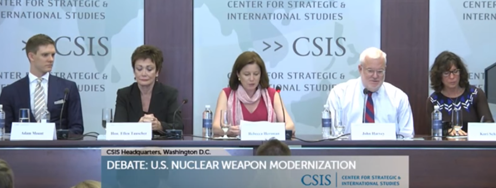Not Just Feasible, Imperative!
As the saying goes, everything old is new again. And so it seems with nuclear weapons. Calls for abolishing nuclear weapons are as old as the Manhattan Project that created them. Since that time, there have been ebbs and flows of progress, public attention and political energy devoted to the goal. Today, we are seeing an impressive new momentum and urgency to achieving real and lasting reductions in the world's nuclear arsenals, with complete elimination as the ultimate goal. So, what's new?
What's new is the depth, breadth and power of those embracing the vision of a nuclear-weapons free world. Gone are the days when advocates of elimination were characterized as idealistic - code for unrealistic, or limited to a fringe of society. Today we are witnessing a growing recognition among high-level world leaders, many of them with impeccable international security credentials, that nuclear weapons have become a liability rather than an asset. These weapons present risks in and of themselves and should not be retained by anyone. While the idea may be old, the circumstances are new. Three fresh realities make the present efforts to reduce and then eliminate nuclear weapons not only feasible, but imperative.
Reality Number One: There is a growing recognition that, whatever the past may or may not say about nuclear deterrence, today's world offers essentially no credible circumstances under which nuclear deterrence "works." The relationships among the charter members of the nuclear club have become so interdependent that to suggest that one state is deterring another by way of its nuclear arsenal does not stand up to scrutiny. In addition, conventional weapons have become so characteristically different from the World War II era that they offer sufficient deterrence already. And the highest priority nuclear risk - that of nuclear terrorism by a non-state group - is inherently undeterrable. In a nutshell, today's world offers no practical purpose for nuclear weapons.
Reality Number Two: The lie has been put to the notion that some states can have nuclear weapons while effectively working to dissuade others to forgo them. There has been a healthy debate over the years about what motivates states to seek nuclear weapons. Today there is a growing consensus that the existence of nuclear arsenals as a core part of US, and other nation's, security posture makes effective proliferation and disarmament nearly impossible. In other words, one cannot preach temperance from a barstool. With the Nonproliferation Treaty Review (NPT) conference coming up in May 2010, expect to see lots of attention to nuclear weapons states' commitments to Article VI and calls for real progress.
Reality Number Three: As mentioned above, today there is a broad and high-level consensus that transcends party lines, generations and nations endorsing and urging that the vision of a world free of nuclear weapons be made an urgent priority for the global community. This is not simply a chorus of former officials and military leaders who are now at liberty to speak more freely. This group includes current elected officials, military brass, presidents and prime ministers from both nuclear and non-nuclear weapons states alike. Not only does this group bring irreproachable credibility to the notion that getting rid of nukes is smart, but they provide the strongest political force for the effort that has ever been available to make it happen.
So, what can we do to make these new realities move us toward the goal? The first steps are not a mystery and, happily, have already begun. The first thing is to get the two 800-pound gorillas of the nuclear weapons world - the United States and Russia - to complete agreements on further, and substantial, cuts to their existing arsenals. The follow-on to the 1991 START Treaty is well underway, and we need to ensure that it is meaningful and passes the U.S. Senate. Secondly, US ratification of the Comprehensive Test Ban Treaty (CTBT) is essential to lend important momentum to stemming further proliferation and freezing development of current arsenals. Thirdly, as broad and deep a commitment as possible emerging from the NPT Review Conference in May that the vision is achievable and urgent and the mapping out of the next steps to get us there.
Paul Carroll is the Program Officer at the Ploughshares Fund. Prior to his work at Ploughshares, Mr. Carroll worked as an independent consultant to several foundations that make grants in the security arena.



